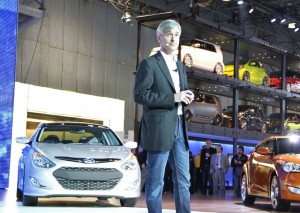The purple seats simply had to go.
There was a time when Korean managers thought that whatever would sell in the home market would be fine with U.S. buyers, including an array of funky paint and fabric colors — at least, as long as the price was low enough. But then Hyundai went into freefall.
Today, U.S. market demands are clearly being taken seriously by Hyundai Motor Co., the maker’s California-based design center playing a serious role in the development of such new vehicles as the quirky 3-door Veloster and i30 – which will soon reach the States as the Elantra Touring.
If anything, expect the U.S. to gain an even more significant role in making key decisions, suggests Hyundai Motor America CEO John Krafcik, because America has lately become Hyundai’s biggest market, a trend likely to continue as the maker surges from one U.S. sales record to another.
Barring an unforeseen and unlikely setback during the final 100 days of 2011, Hyundai is on a path to nip the 600,000 sales mark, up from a record 540,000 last year. In fact, the biggest problem the maker seems to have right now is getting enough vehicles to meet U.S. demand, especially for products like the compact Elantra and midsize Sonata.
“It’s cool to be the biggest global market because then your voice gets louder in global design,” said Krafcik during an interview in Portland, Oregon, where Hyundai was offering journalists a first ride in the new Veloster hatchback. (For the review, Click Here.)
Hyundai has gone through a lot of changes since it first entered the North American market a quarter-century ago. As it much needed. Back then, the emphasis was solely on price, quality and design be damned. So, after an initially meteoric rise the maker crashed and nearly burned out. It was forced to close a plant in Quebec and considered abandoning the North American market entirely.
Caution prevailed and U.S. executives convinced their Korean masters to try a few tricks to rebuild American interest. Quality began to rise and to get that message across the maker announced an industry-best 10-year warranty program.
A critical breakthrough came with the unveiling of the Genesis sedan, four years ago, the mid-luxury model pulling off an upset when it was named North American Car of the Year. For 2011, Hyundai delivered another shock when it went even more up-market with the premium-luxury Equus, which targeted the likes of the vaunted Mercedes-Benz S-Class.
Initially predicting – quite cautiously – the Equus might reach 2,000 sales, the sedan is actually on track to top 3,000, making it one of the best-sellers in its segments.
The Veloster, like the also-new Hyundai Accent, underscores the fact that Hyundai is not abandoning the low-end niches that were long its bread-and-butter. But its unusual 3-door styling shows “We’re going our own way,” said Krafcik, a former Ford engineer. “We don’t need permission to do that.” Even from Korea, it seems, these days, as the U.S gets more say not only in marketing matters but also basic vehicle design.
On the marketing side, however, Hyundai has shown an equally surprising level of creativity. The 10-year warranty was followed by a variety of unusual programs, including one that offered to buy back a car if a buyer lost their job. The newest campaign sets a minimum trade-in value for Hyundai products, overcoming one of the most frequent concerns buyers face when purchasing a new vehicle.
Such programs have dramatically increased the number of buyers will to put a Hyundai on their shopping list. Just five years ago the brand’s “consideration rate” was barely one in six. Today, 36% of U.S. motorists would consider a Hyundai, only slightly less than better-established Nissan’s 42%.
Perhaps more surprising, the loyalty rate – measured by those who trade in on the same brand of vehicle – has surged to 52.3%, notably ahead of Honda, at 49.7%, and Toyota, at 47.7%.
There’s another number that’s more troubling. Hyundai is currently operating with just a 20-day supply of vehicles in U.S. showrooms, according to Krafcik, compared with an industry norm of 50 to 60 days. That means the maker often finds customers waiting when the trucks reach its showrooms.
There’s a concerted push to eliminate bottlenecks and boost production at the Hyundai plant in Alabama. The maker has even gobbled up some space on the Georgia line operated by its Korean sibling, Kia.
“We’re flat out” on some models, like the Genesis Coupe, insisted Krafcik.
Industry observers would not be surprised to see either a major expansion of that still-new factory – or the addition of an entirely new plant – in the next several years.
Krafcik would not confirm either approach but he cautioned that before Hyundai commits it will want to be sure it can maintain momentum. It has seen big sales gains come crashing down and has no desire to repeat the experience in Quebec. So, to look forward, it also has to look to its past.
The good news is that it has figured out that the purple seats don’t work here. But now it has to prove it can continue to deliver eye-catching products like Sonata and Elantra and maintain the quality Americans demand.

